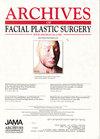Retrospective review of resorbable plate fixation in pediatric craniofacial surgery: long-term outcome.
引用次数: 11
Abstract
Objective: To determine the long-term efficacy of resorbable plate fixation in pediatric patients undergoing craniofacial surgery for congenital anomalies, traumatic deformities, or skull base tumors. Design: Retrospective case review. Materials and Methods: Medical records of 57 consecutive cases using resorbable plates and screws for craniofacialfixationinpatientsyoungerthan18yearswereanalyzed. MainOutcomeMeasures:Thestatusofbonehealingpostoperatively(anatomicalunion,malunion,delayedunion, or nonunion) and any complications or adverse effects (hardware visibility or palpability, plate extrusion, or infection) were noted. Results: In midfacial and upper face procedures (54 patients) anatomical union and uncomplicated bone healing occurred in 52 (96%) of the patients. In this same group, complications (plate extrusion) occurred in 2 patients(3.7%)andwereresolvedusingconservativetreatment without untoward sequelae. These outcomes are comparabletoresultsusingmetalosteosynthesisinsimilar situations. Costs of resorbable hardware are similar to existing metal fixation systems. Conclusions: Our data support the use of bioresorbable platefixationinpediatriccraniofacialsurgeryasameans of avoiding the potential and well-documented problems with rigid metal fixation. Indications include fractures and segmental repositioning in low-stress nonload-bearing areas of the middle and upper craniofacial skeleton. Although there is an initial learning curve in using this technology, we believe the benefits are well worth the effort and represent a major advance in pediatric craniofacial surgery.儿童颅面外科可吸收钢板固定的回顾性研究:长期结果。
本文章由计算机程序翻译,如有差异,请以英文原文为准。
求助全文
约1分钟内获得全文
求助全文

 求助内容:
求助内容: 应助结果提醒方式:
应助结果提醒方式:


